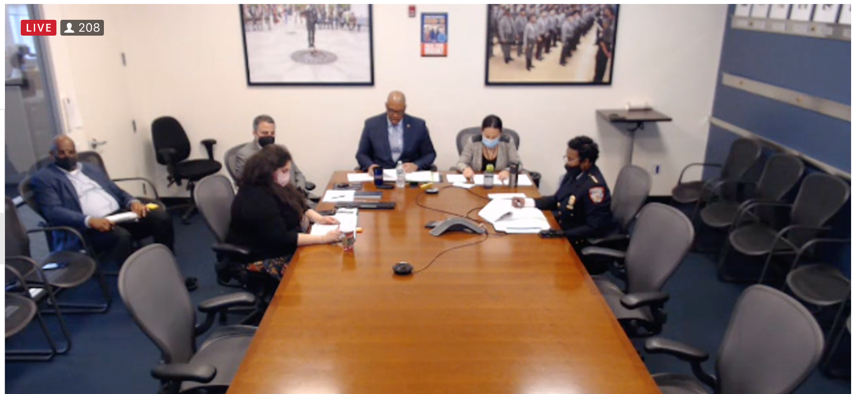Criminal Justice
Questions loom about the plan to close Rikers, as new administration takes over
The City Council heard a final update from the de Blasio administration. But what do the new guys think?

Department of Correction officials testify to the City Council Committee on Criminal Justice. Jeff Coltin
New York City’s plan to close Rikers Island and build four new jails is still moving forward – but how much will it change between now and 2027?
Monday’s New York City Council oversight hearing on the borough-based jail plan did little to shine light on the challenges that face the $8.2 billion proposal. Almost no opponents of the plan – including the powerful Correction Officers Benevolent Association – were heard from, and the fact that Mayor-elect Eric Adams and key incoming City Council members oppose key parts of the plan went almost entirely unmentioned.
New York City Mayor Bill de Blasio set the proposal in motion and detailed plans passed the City Council in Oct. 2019, but it will be Adams’ administration, set to take office on Jan. 1, that will be doing most of the implementation and overseeing construction of jails. Adams has broadly committed to the plan, but has also entertained criticism of it. He’s maintained much closer ties to COBA than de Blasio ever did, and has talked about changing the location of the South Bronx jail site, as well as the one in Lower Manhattan. While City Council Members Margaret Chin of Lower Manhattan and Karen Koslowitz of Central Queens supported building new jails in their districts, they’re being replaced by Council members – Chris Marte and Lynn Schulman, respectively – who explicitly campaigned on keeping new jails out of their neighborhoods.
In theory, there’s little they can do to stop it. The Uniform Land Use Review Procedure for the borough-based jails already passed, and contracts to dismantle the existing sites and prepare them for construction will be awarded by the time de Blasio leaves office, Sasha Ginzberg, executive director of the Borough Based Jail System, said Monday. “Sitework will begin in early 2022, paving the way for the delivery of smaller and more humane facilities to be in place by 2027,” she said.
But in practice, Adams’ administration will be the one administering those contracts, and he could always make changes. The timeline to complete the new jails has already been pushed back a year under the de Blasio administration to 2027, and Adams has made no promises himself on the timing. Adams’ campaign did not respond to a request for comment on his plans for the jails, but there is every expectation that Adams will be replacing top leadership at key agencies including the Department of Correction, the Mayor's Office of Criminal Justice and the Department of Design and Construction.
Monday’s three hour and nine minute hearing hosted by the Committee on Criminal justice did serve as an opportunity for the de Blasio administration to give a final, public update on the progress of one of its key initiatives. While speaker after speaker emphasized that the plan was on track, officials also had to acknowledge that the jail population has been trending in the wrong direction. New York City jails had an average population of 5,443 in October 2021 – a nearly 1,000-person increase from Oct. 2020, when an average of 4,446 people were incarcerated. The four new jails are planned to have a total of 3,300 beds. The borough-based jail plan, Richards said, “is, at its core, a jail population reduction plan.” But if the number of people incarcerated in New York isn’t drastically and consistently reduced in the coming years, Adams will have no choice but to alter the jails plan. The mayor of New York has some limited say and influence over the amount of people held in jail, but the issue goes well beyond City Hall – just look at de Blasio’s ongoing debates with the state legislature over bail laws and the court system over pandemic-related delays.
City Council Member Keith Powers, who chairs the Criminal Justice Committee, said Monday’s hearing was a way to get an update on the progress the administration has made since the plan passed two years ago. Though closing Rikers has been a controversial issue, the vast majority of speakers testifying Monday were supportive of the plan (though many in particular took issue with the proposal to have all women incarcerated at the jail in Queens, with some thinking a more centrally located facility in Manhattan would be better). COBA, which did not respond to a request for comment, and other critics of the city’s plan simply declined to show. “Everybody’s always invited,” Powers told City & State. “It was publicized like any other council hearing. I can’t speak to why people showed up or didn’t show up.”
Powers is in the midst of a competitive campaign to be the next City Council speaker. This may have been his final hearing as committee chair, and in his closing remarks, he acknowledged that the future of the plan to close Rikers isn’t entirely clear. “It’s essential and important that we continue these conversations,” Powers said. “No doubt, whether it’s in one administration or one Council or others, the work continues to make sure we have a safe, humane and fair criminal justice system, including where and how are housing people that are facing trial here in New York City.”
While conditions at Rikers Island and other city jails have always been considered decrepit and violent, the situation seems to have gotten even worse in the last few months, for both people who are being jailed and the correction officers who are supposed to watch them.
Powers said that’s only refocused the efforts to create a new jail system in the city. “The last few months has really demonstrated people’s desire to get off Rikers Island,” he said.

NEXT STORY: JCOPE action on Cuomo book deal seen as ‘small’ step toward righting marred history

